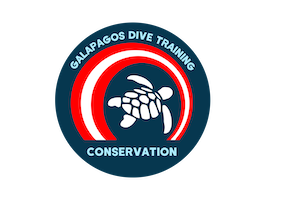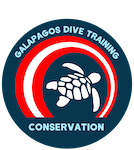OUR OTHER DAY DIVE SITES
Come explore our world class diving!
Introduction
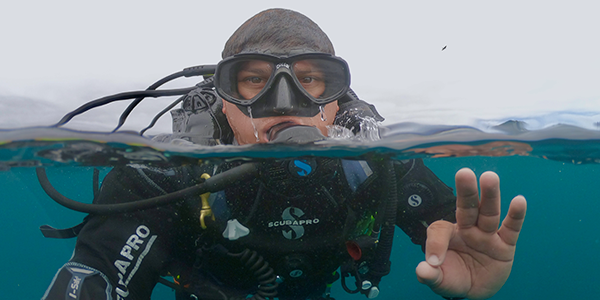
For experienced clients holding at minimum a PADI Advanced Open Water certification (or a comparable qualification) we widen the variety of dive sites we offer by collaborating with the best of the other scuba operators in Puerto Ayora. If you were to dive with any one these third-party operators, you would be tied to the dive itineraries each is set by the National Park Authority. By allowing us to arrange your schedule, we can select the best options from each individual operator and design your dive experiences to meet your personal interests.
Please be aware:
If you choose a dive destination to the south or east of Santa Cruz Island, your boat will depart directly from the harbour in Puerto Ayora between 07.00 and 08.00 and run times in each direction will be 1 and 2 hours.
If you choose a dive destination to the north or west of the Island you take a 45-minute car ride north from Puerto Ayora to the ‘Itabaca Channel’ close to Baltra Island, departing between 07.00 and 08.00. Thereafter, your boat run time will varying between 30 minutes and 1 hour and 30 minutes in each direction, depending on the destination.
Whichever route you select you will complete two dives during the trip and enjoy snacks and refreshments during dive intervals. Regardless of the destination, you can generally expect to be back at your accommodation between 15.30 and 16.00 hrs.
Our long-range, daytrip, dive locations
BARTOLOME
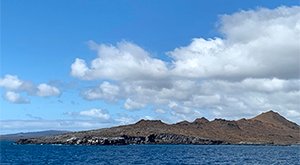
Located to the NNW of Santa Cruz Island and the east of Santiago Island, travel time is 90-120 mins depending upon road and sea conditions.
Dive Difficulty/Qualification required, at minimum Open Water Diver. This sites often has weak to moderate currents, but conditions can be more challenging.
Bartolome is generally good for both novice and seasoned divers. Entry is made in a shallow area which leads on to rocky outcrops surrounded by sand, depth of 18-20 m.
White tip reef and other sharks are commonly seen, as are sea lions, turtles, barracudas, sting rays, reef fishes, and a variety of invertebrates. Large manta rays and squadrons of mobula rays are sometimes present.
During the surface interval, the dive boat often approaches Bartolome pinnacle searching for penguins.
Note, Bartolome and Cousins are usually dived in combination.
To book a place on one of these trips please Contact Us.
COUSINS
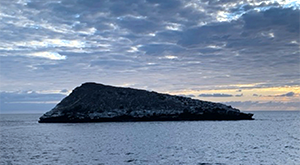
Like Bartolome, Cousins, is located to the NNW of Santa Cruz Island and the east of Santiago Island, travel time is 90-120 mins depending upon road and sea conditions.
Dive Difficulty: Qualification required, Open Water Diver. There are often no strong currents at this site, making it ideal for beginners, and an attractive place for the experienced diver to relax, but current can sometimes be far more significant.
Much of the wall at Cousins is covered in soft black coral which provides the opportunity to hunt for the Pacific seahorse.
Much of the wall is covered in soft black coral which provides the opportunity to hunt for the Pacific seahorse.
Expect to also see some of the following, sealions, green sea turtles, cleaning stations and white tip reef sharks, Galapagos sharks, barracuda, manta, mobula, eagle and sting rays, reef fishes, and a variety of invertebrates.
Note, Bartolome and Cousins are usually dived in combination.
To book a place on one of these trips please Contact Us.
DAPHNE MINOR
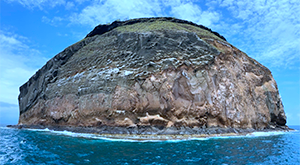
Located relatively close to and slightly NNW of Santa Cruz Island, travel time is generally about. 50-60 mins from Puerto Ayora depending upon road and sea conditions.
Dive Difficulty: Qualification required, Open Water Diver. There are normally no strong currents at this site which has a rocky and sandy bottom.
An exposed rock provides for a single dive site, with a small cavern housing resting white tip reef sharks. Offset, there is a pinnacle around which can be seen turtles, a diversity of rays, Galápagos sharks, barracudas, coral reef fishes, and black coral walls with a variety of invertebrates. Daphne is also renowned for a large shoal of Salima fish, which can sometimes be found at the site.
Note, Daphne Minor is usually dived in combination with either Mosquera or one of the North Seymour sites.
To book a place on one of these trips please Contact Us.
GORDON ROCKS
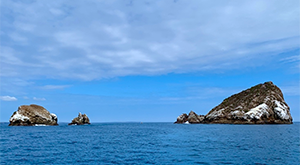
Located to the northeast of Santa Cruz Island, travel time is generally about. 60-70 mins from Puerto Ayora, depending on transit conditions.
Dive Difficulty: Qualification required - Advanced Diver recommended. Gordon Rocks can sometimes be a quiet and easy dive, but it is known for strong currents and surge. Please seek our advice if you have fewer than 25 dives.
The remnants of an extinct volcanic crater with a sandy bottom at 32 meters, the wall around the outside of Gordon Rocks drops to more than 65 meters.
The site has three exposed pinnacles surrounding the crater, a further three submerged beneath the surface, these rising to between 6 and 8 m at the northern edge of the crater, and a large central pinnacle, approximately 21 m below the surface.
The conditions at Gordon Rocks attract schools of hammerhead sharks and it’s not unusual to see 50 such animals, maybe even more if you’re lucky
White and blacktip reef sharks, and Galapagos sharks also frequent the area, as do sea lions, green sea turtles, stingrays, eagle and mobula rays, large schools of barracuda and snapper, and a variety of invertebrates. Occasionally, manta ray and the ocean sun fish (Mola mola) are also spotted.
Note, Gordon is often offered as a double dive but sometimes it is combined with a dive along the coast of Santa Cruz.
To book a place on one of these trips please Contact Us.
MOSQUERA (NORTH AND SOUTH)
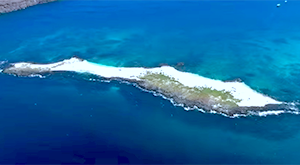
Located to the north of Santa Cruz Island, between North Seymour and Baltra islands, travel time is usually about 60-70 mins from Puerto Ayora, depending upon road and sea conditions.
Dive Difficulty: Qualification required, Open Water Diver. This site generally has mild to moderate currents.
Mosquera is an islet (sand bar) emerging from the seabed and popular with sea lions, which regularly follow divers when they visit. The site offers gentle drift diving over broken sandy areas with rocky promontories, good for black coral and invertebrates. At approximately 21 m, the seafloor opens to full sand, where a large population of Galapagos garden-eels can be found.
Diving at Mosquera is relaxed and frequently geared to viewing the many eagle rays, mobulas, golden rays, hammerhead sharks, blacktip reef sharks, and occasional Galapagos sharks and manta rays that pass in the blue.
The more northerly site presents a rocky area that connects with Seymour channel. This can sometimes provide for very good shark viewing.
Note, Mosquera is sometimes offered as a double dive and on other occasions is combined with a dive at Seymour or the coastline along Santa Cruz.
To book a place on one of these trips please Contact Us.
NORTH SEYMOUR (CHANNEL)
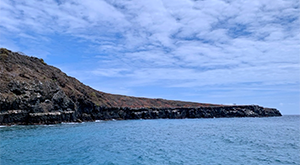
Located to the north of Santa Cruz Island, travel time is generally like that for Mosquera.
Dive Difficulty: Qualification required, Open Water Diver. Although currents can be moderate to strong upon occasion, Seymour Channel is an excellent location for both novice and experienced divers and is well known for its drift diving potential.
The topography at North Seymour Point is characterized by gradually descending steps from the shoreline to a rocky reef at about 8 m which descends to a sandy bottom at 16–18 m
With reefs over a sandy bottom. The site has a lot of fish cleaning stations, these attracting Galapagos sharks, white and black tip reef sharks, and hammerhead sharks. Also seen regularly are, sea lions, turtles, mobulas, sting rays, eagle rays, Galapagos eels, barracuda, reef fishes, and a variety of invertebrates.
Note, because of the proximity of the Point to the Channel, the two locations are often dived in combination. Alternatively, the dive might visit either Mosquera or Daphne Minor.
To book a place on one of these trips please Contact Us.
NORTH SEYMOUR POINT

Located to the north of Santa Cruz Island, travel time is generally like that for Mosquera.
Dive Difficulty: Qualification required, Open Water Diver. Although currents can be moderate to strong upon occasion, North Seymour Point is an excellent location for both novice and experienced divers and is well known for its drift diving potential.
The nearshore area is with a rocky bottom and small caves at approx. 12 m. Here you can find turtles and sharks resting. Out in the blue, large pelagic fish are frequently found including Galapagos and hammerhead sharks. Other commonly seen animals are mobulas, sting rays, eagle rays, Galapagos eel, barracudas, turtles, reef fishes, and a variety of invertebrates.
Note, because of the proximity of the Point to the Channel, the two locations are often dived in combination. Alternatively, the dive might visit either Mosquera or Daphne Minor.
To book a place on one of these trips please Contact Us.
